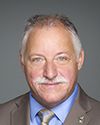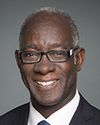Okay.
Are there other comments?
Evidence of meeting #44 for Veterans Affairs in the 44th Parliament, 1st Session. (The original version is on Parliament’s site, as are the minutes.) The winning word was research.
A video is available from Parliament.
8:15 p.m.
Conservative

Blake Richards Conservative Banff—Airdrie, AB
If we're going to stay, we should let everyone have an opportunity to speak.
8:15 p.m.
NDP
8:15 p.m.
Liberal

Darrell Samson Liberal Sackville—Preston—Chezzetcook, NS
We can run the clock until 8:30. That's what I understand.
8:15 p.m.
Liberal

The Chair Liberal Emmanuel Dubourg
Let me be clear. We are in the second round, so I have two and a half minutes for Mr. Desilets and Ms. Blaney, and five minutes for the Conservatives and the Liberals.
It's now 8:20. We have 10 minutes to go on with that. We only have 10 minutes.
8:15 p.m.
Conservative

Blake Richards Conservative Banff—Airdrie, AB
We have two and a half minutes and five minutes. We have 10 minutes, so that would be two and a half, two and a half and five minutes over here. Is that correct?
8:15 p.m.
Liberal

Darrell Samson Liberal Sackville—Preston—Chezzetcook, NS
Or we could have two and a half, two and a half, two and a half and two and a half, shared with the Conservatives.
8:15 p.m.
Conservative

Blake Richards Conservative Banff—Airdrie, AB
My understanding is that we're going to follow the normal order.
What's the normal order? That's what I was trying to understand.
8:15 p.m.
Liberal

The Chair Liberal Emmanuel Dubourg
I agree. That's the normal order.
I understand that you want to continue with the order until 8:30. Okay.
Mr. Desilets, the floor is yours for two and a half minutes.
8:20 p.m.
Bloc

Luc Desilets Bloc Rivière-des-Mille-Îles, QC
Thank you, Mr. Chair.
Mr. Svenson, can you tell me how many employees are on your team and what your budget is?
8:20 p.m.
Director, Research, Department of Veterans Affairs
We have about a dozen researchers.
As for our budget, I'll provide the accurate numbers, because I don't have the exact number in front of me. We'll come back to the committee with the actual budgets, but we have about a dozen researchers.
8:20 p.m.
Bloc

Luc Desilets Bloc Rivière-des-Mille-Îles, QC
That would be good of you, thank you.
Do you think it would be a good idea to increase the budget in order to compile the results and take it further?
It's fine to have results, but if you can't find the root causes, it will be hard to form an intervention plan.
Are you thinking of expanding your mandate?
8:20 p.m.
Director, Research, Department of Veterans Affairs
My function doesn't extend to departmental budgeting, so I can't comment on budget matters. I'm sorry.
8:20 p.m.
Bloc

Luc Desilets Bloc Rivière-des-Mille-Îles, QC
In this case, do you think the number of employees you have meets the present demand?
8:20 p.m.
Director, Research, Department of Veterans Affairs
The most important factor for us in mobilizing our research capacity is the extent to which we can work successfully with partners who are experts in many fields.
Dr. Garland Baird mentioned CIMVHR, the Canadian Institute for Military and Veteran Health Research. We also fund research through the Atlas Institute for veterans and their families and the Chronic Pain Centre of Excellence for Canadian Veterans. Together with those organizations and many academic partners across the country, we can achieve a lot of things, and a lot of researchers are willing to work with us. It's a matter of finding the right people and collaborating with them.
8:20 p.m.
Liberal

The Chair Liberal Emmanuel Dubourg
Thank you so much, Mr. Svenson.
Now let's go to Ms. Blaney for two and a half minutes, please.
8:20 p.m.
NDP

Rachel Blaney NDP North Island—Powell River, BC
Thank you so much, Chair.
To the witnesses, how does VAC communicate its veteran health-related research findings back to women veterans and to the civilian health care providers? I know that about 80% of veterans are not VAC clients. I'm just curious to know how you get this information out and how you get it out to the health care providers who work with them.
8:20 p.m.
Director, Research, Department of Veterans Affairs
We do that through a variety of ways. Some of the services VAC funds, such as mental health care services, are complementary to services provided through provincial health care systems. It's easier for us to be connected with the care providers in those fields. For example, we administer a number of operational stress injury clinics across the country. Those clinics operate in the provinces under the provincial health care systems, but we have close relationships with those clinics, so it's easier for us to share and distribute best practices. We have those communication channels open.
It's more challenging in some other aspects of care delivery. That is one of the reasons we established those two centres of excellence. There's the centre of excellence on mental health, Atlas, and the centre of excellence on chronic pain for veterans, because those were very.... Mental health and chronic pain—
8:20 p.m.
NDP

Rachel Blaney NDP North Island—Powell River, BC
Okay. I think I got it. I have a very short time.
I'm wondering about how the support from the minister and other senior officers works with the department and whether there's ever an opportunity when you're asking for more resources and you don't get them. I'm wondering how those two things work together—the senior officials and the minister's office, and the work you do in research.
8:20 p.m.
Director, Research, Department of Veterans Affairs
Thank you for the question. I'm not sure I understood it completely, but I can say that when good ideas have come by and we've made logical suggestions, the ears have been open within our department to explore new or compelling areas for research. That's not a constraint, in my mind, if that answers your question.
8:25 p.m.
Liberal

The Chair Liberal Emmanuel Dubourg
Thank you, Ms. Blaney.
Now let's go to Mr. Blake Richards for five minutes, please.
8:25 p.m.
Conservative

Blake Richards Conservative Banff—Airdrie, AB
Thanks, Mr. Chair.
I have three quick questions. Maybe we can even leave a little time for one of my Liberal colleagues, if we can get through them quickly.
The first question I have is a bit of a follow-up to Mr. Dowdall's question earlier. He asked you about the differences between DND and VAC when determining what a service-related injury is. You were going to get back to him with some information. I'm going to ask you about something kind of related. Maybe you can answer it now, but if you can't, you can also get back to us with this information.
It's with regard to when we're talking about the assessment of injuries in particular. What often happens is that the injury happens at some point during service. Later on, the effects of the injury start to take their toll. The veteran comes looking for assistance, and there seems to be a loss of the documentation somewhere along the way. Often it seems as though it's in the transition from DND to VAC.
I'm wondering if you've done any work to try to determine what is causing that and what suggestions you've been able to come up with to help prevent it from happening in the future, or at least minimize it.
8:25 p.m.
Director, Research, Department of Veterans Affairs
I'm not familiar with the specific protocols for information transfer between the departments, but we'll come back to the committee with that information.
8:25 p.m.
Conservative

Blake Richards Conservative Banff—Airdrie, AB
It would be great if you could. If you could tell us what work is being done, if any, to try to ensure the documentation isn't being lost so veterans can make sure they get the help they need, that would be helpful. We'll leave that with you to get back to us on.
I have another follow-up to a question Mr. Dowdall asked earlier—or at least I think it was Mr. Dowdall—about the number of veterans employed at Veterans Affairs. You'll probably have to get back to me with this one because you didn't have the number there, but do you know the number of veterans employed in the federal public service more generally? Could you give us a number on that? If not, could you provide it?